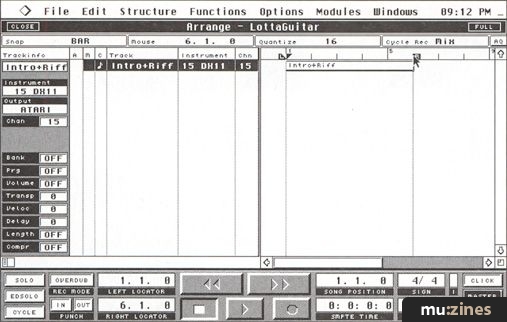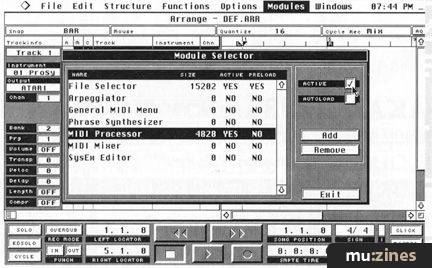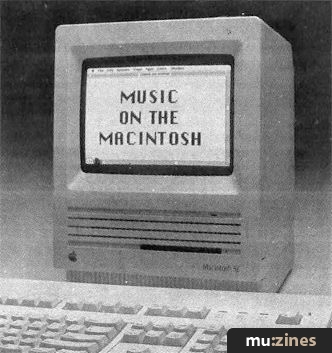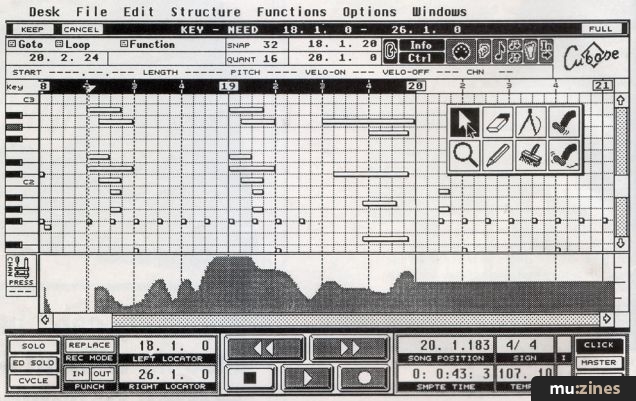Magazine Archive
Home -> Magazines -> Issues -> Articles in this issue -> View
Time to Score! | |
Steinberg Cubase Score Sequencing & Score Printing Software For MacintoshArticle from Sound On Sound, October 1993 | |
Steinberg have expanded their portfolio of Mac programs with this integrated MIDI sequencing and score printing package. Does it knock the American favourites for six? Mike Barnes investigates...

Whilst the early incarnations of Cubase on the Macintosh were notoriously under-specified and buggier than their Atari cousins, this latest version is feature-packed and stable. Now with Cubase Score, Steinberg are taking on the Americans (Opcode, MOTU and Passport) and arch rival E-Magic's Notator Logic, and have come up with a musician-friendly, integrated sequencing/scorewriting package which blends power with ease of use.
SYSTEM REQUIREMENTS
The software arrives as a three disk set (one Program disk, and two disks worth of supplemental files), bundled with a hard ring-bound file of comprehensive and accessible documentation courtesy of the unmistakably-named Cubase guru, Ernst Nathorst-Böös. Fortunately, the text is more legible than the author's name, so us Anglophiles can actually dip in and find information rather than the usual utter confusion rapidly followed by destructive urges induced by that old Pro-24 manual. The software is accompanied by a red matchbox-sized hardware key (dongle), which attaches to the Apple Desktop Bus (ADB) via a supplied cable, and there is even a special software driver just to double-check that you installed the software from the installer off those original master disks. No risk-taking here. Having experienced widespread pirating of Cubase on the Atari (cracked v2 ST Cubase seems to be the industry standard for many into 'grooves' and lopsided baseball caps!), the Mac version has been well protected and the red dongle is your only passport into the program. Given that musicians had their chance and proved conclusively that they still loathe to spend money even on the most useful and fundamental aspect of modern music-making (ie. sequencing/composition software), then it appears that this sort of hardware protection is the only way forward in the music software business.
Cubase Score requires an ADB-equipped Macintosh with a hard drive, at least 4MB of RAM and System 6.0.7 or later. It's fully System 7 and Virtual Memory compatible and can run under Apple MIDI Manager or via direct port access. All standard Mac MIDI interfaces are supported, and for power-users up to four MOTU MIDI Time Pieces (MTP) can be run simultaneously (giving 512 MIDI channels if you wish!) or Opcode's Studio 4/5 can be run in 'MTP emulation' mode.
The software installation process can be automated via the standard installer program, which picks up the right sections of software and dumps them in (usually) the right place on your hard drive. Strangely, the installer seems to get into a little difficulty should you want to install the software onto a drive that does not contain the System (eg. a Syquest cartridge), but even so, once installed on your main drive, the main program can be moved around and backed up as required.
Another more annoying quirk is the frequency with which, once installed, Cubase Score decides not to recognise that the hardware key is actually connected and the user is forced to shut down, replug the key, reboot and try again. Seems that the transition to hardware keys is not quite as smooth as it could be...
BUNDLED GOODIES
No complaints about Steinberg's generosity when it comes to bundled goodies. On the additional files disks you receive a plethora of assistance to get you started in terms of Groove Templates (for adding realistic 'feel' to your quantising efforts), Drum Maps (for setting up drum machine note-tables) and Mixer Maps (for editing/controlling common MIDI devices). There's even a copy of 'MIDI Xplained', an on-line MIDI Help System written by the author of the Cubase manual, filled with tips and a troubleshooting guide which will no doubt prove invaluable for those who might be taking their first serious steps in the world of MIDI. For existing hardcore Mac users, a template file for use with JL Cooper's CS1 transport control interface is also included.
CUBASE OVERVIEW
Cubase Score is structured like most modern software sequencers with a main 'living and working' window, from which you jump to specialised windows for editing and detailed setup operations. A standard menu system runs across the top of the screen providing click-and-select access to all the functions and parts of the working environment. Movement between modes of operation is free, since the program is multi-tasking, which allows the user to do almost anything (including loading and saving to disk) without interrupting the creative flow of the music.
The main Arrange window provides access to a track list and a graphical map (called the Part Display) where data can be organised quickly into intuitive, visual blocks rather than resorting to numbers or even the score. Below the track list lies the book-like 'Inspector' icon, which pops up a list of real-time playback parameters for whatever musical part(s) are selected. These parameters give rapid access to, for example, transposition, program number or volume, and may be changed on-the-fly. In common with its competitors, Cubase Score has a dedicated Transport Bar which groups all the key tape recorder-like functions together with locators, counter and tempo/meter indicators. The Transport Bar can be moved around the screen and positioned wherever is deemed convenient.
From the Arrange window, it is straightforward to jump into any of the various editors (Score/Grid/Drum/Event-List/Logical) by selecting a recorded part that you want to edit and then choosing the appropriate type of editor from the menu list. A specialised window pops up to allow data to be manipulated using any of Cubase's powerful graphical or numerical methods.
RECORDING/ARRANGING
After briefly entering the MIDI Setup dialog box to tell Cubase what type of MIDI interface you are using, where it sits and the MIDI environment you want to run in, the system is ready for action. Recording of any type of data into Cubase Score is simple but means first selecting a track, then defining its class and any relevant MIDI port/channel. In Cubase Score, there are five types of track:
• MIDI tracks (for regular MIDI recording)
• Drum tracks (for use with drum editor)
• Group tracks (for organising parts)
• Mix tracks (for recording MIDI Mixer events)
• Tape tracks (for controlling tape recorders)
By now, the terminology of sequencer recording is no doubt familiar to even the humblest washboard player, so suffice it to say here that Cubase Score offers linear and loop (cycle) recording, as well as punch-in/punch-out, though it is peculiarly vague on the aspect of simultaneous multi-channel recording.
Once recorded, data can be seen as visual blocks indicating the length of a particular phrase or part. These parts can be grabbed with the mouse and moved around over time, moved to play on another track, duplicated, ghosted (a sort of clone linked to the original parent data), divided or edited.
The editing options consist of the standard MIDI event list, a Score representation, a grid representation, and in the case of a drum track, there is also a drum grid. A further non-graphical option, called Logical-Edit, is also available for making precise mathematical modifications to particular categories or regions of data.

Score edit page showing Toolbox (top right) and Transport Bar.
SCORE LAYOUT
Cubase's Score facility has focused on the key elements for producing basic, good-looking scores: titling, copyright/publisher's information section, lyrics, chord symbols, guitar chord boxes, bar numbering, key signature and multiple clef representations. Generally speaking, you are free to position any of these data types where you like, within some boundary restrictions, though where there are fixed positions the choice of location seems acceptable. Steinberg provide TrueType fonts for screen display and PostScript fonts for printout. Incidentally, the score fonts used for printout by Notator, Cubase and programs such as Coda's Finale are all slightly different, and whilst they are all of course legible, some purists may have a leaning towards a particular 'style'.

Cubase Score Symbol Palette.
When in Score-Edit, the Toolbox offers note input and rest tools, so that new musical events can be added in addition to altering existing events. Whilst trying to steer away from 'frills' where they might add over-complexity, there are several neat functions. For instance, the software can automatically extract the chord names from your MIDI data (even polychords to some extent) and write them above the bars, and the user is free to denote guitar voicings for these chords by placing the dots on the guitar-neck template using the mouse. Also, there are a few 'auto tidy-up' functions available, such as Display Quantise, and simple control of beaming and overlap, though not as extensive as Notator.
Other key functions include the ability to 'explode' a chord from one stave on to multiple monophonic staves, and then remap each stave to a different MIDI output in order to create a harmonic passage using several different instruments (as in a string section).
EXOTICA
Apart from the standard editing fare on offer, Cubase Score has a few of its own unique tricks and some twists on ideas borrowed from competitors. Firstly, the MIDI Processor is like a MIDI signal processor that can be patched into a track to add echoes, chorus or pitch-shifting. It is certainly not as powerful as the combination of delay/transform/arpeggiator objects in Notator Logic, but on the other hand it requires none of the setting up and is straightforward and ready to go.
The grandly titled Interactive Phrase Synthesizer (IPS) is no doubt worthy of a detailed explanatory article in its own right, but in the context of this review it can be outlined as follows. In order to spark some new ideas from some riffs or phrases that you have already recorded, the IPS can be used to process and interpret a section of music that you give it as raw material to work on. However, it's not a case of throwing in some data and just hitting 'go'. The user is actually responsible for modelling the music that comes out by playing something in real time (via the MIDI Input module) and also by making parameter settings in the Interpreter Module. Thus the user directly controls how dramatically the IPS modifies the raw materials and broadly in which harmonic, melodic and dynamic direction. Like most idea generators, it is basically a case of garbage in, garbage out, and wresting anything usable from it requires more than a casual parameter tweak. Nonetheless, there are no doubt some hardcore IPS users who can work miracles with the system, so it's there if you feel the urge.
The Logical Editor module is fundamentally different to the other editors in that it involves applying formulae to musical data in a direct mathematical or logical way. Essentially, it allows those with a good understanding of MIDI to change data in a precise, detailed way, only affecting particular types of MIDI data or even just certain narrow values. It allows the user to set up commonly used logical modifications as 'Presets', which can then be quickly recalled via a menu.
The idea of the Mixer Map is that even the novice MIDIphile can assemble a series of predefined graphical control objects (such as knobs and sliders) into a control surface designed to control synthesizers or MIDI mixers from either MIDI Controllers or System Exclusive messages. These objects can then have their values changed with the mouse and their movements recorded into a 'Mix Track' for automated control of a device. Cubase Score also allows 'snapshots' to be taken, capturing all of the static object settings at a particular moment in time — like a sort of MIDI photograph.
It is possible to load up to eight different mixer maps to control different devices, each containing a maximum of 128 objects, and objects can be grouped to form related clusters controlled by a 'master' object. The system is easy to use and is ideal for most small projects, but does fall down (by running out of available objects!) if it is called upon to control a piece of gear with a lot of parameters (such as fully implementing a modern day synthesizer or advanced MIDI mixer such as the Yamaha DMP series). Perhaps this is beyond what some would call a 'reasonable' task for what is essentially composition software, but both MOTU's Performer and E-magic's Notator Logic make provision for very complex and sophisticated control surfaces (even though this makes them a little more difficult to familiarise yourself with). Notator Logic, by way of comparison, has no limit on the number of objects in a control surface other than that dictated by the memory in your Macintosh!
CONCLUSIONS
Whilst the overview given here doesn't represent a particularly long period of time spent with the software, it is nonetheless clear that Cubase Score is amongst the easiest to use sequencing/scorewriting systems available for the Macintosh, and now provides high quality printed score output to boot. However, there are a few key features missing that could potentially tempt you in another direction — such as the elaborate studio configuration, instrument definition and patch name management offered by Performer and Notator Logic, and the popular multiple timebase Markers window in Performer, but then again, not everyone is aiming to control huge racks of studio gear or is regularly syncing to tape or video. Similarly, whilst Cubase Score is ideal for producing pop/rock scores, it does not pretend to have the same degree of flexibility as dedicated score publishing packages like Finale. Because these different issues and sometimes seemingly insignificant features can actually be key deciding factors for some potential purchasers, perhaps an analogy is a better way of summing up where Cubase Score fits into the grand scheme of things. Here goes...
After chewing over the spec and performance, at the end of the day what it all boils down to is that choosing a sequencer is a very personal thing, which reflects many factors in the same way as choosing a car. For some of us, a particular model is all we can afford or just a tool to get us from A to B (ie. in this case to create music!). For some it's a statement of style or taste, for others it just works in the right way or might merely be an attractive piece of visual engineering. And for those with money to burn, it's another opportunity for one-upmanship in the status symbol stakes. Also, just like cars, sequencers seem to have fashion fads and an undulating cycle of being in vogue and out of vogue, and right now German sequencers are definitely 'in'.
These days for new Mac sequencer buyers, it is becoming harder and harder to justify buying a much-loved American 'classic' such as MOTU's Performer. Why? Because despite some recent innovations (such as the in-built System Exclusive patch manager) Performer is suffering from a lot of fancy trimmings and go-faster stripes hanging off an old chassis (Performer was basically the original Mac sequencer and has an eight year history) and it isn't helped by a notoriously sluggish performance on even not-so-low-powered Macs. In many ways, Opcode's Vision is the opposite; a sort of Indie racer sparsely built for maximum speed and performance, reliable under pressure and enduring, but with minimal frills and missing a little in the driver refinement stakes. E-Magic's Notator Logic is something of an enigma; like a newly modelled Mercedes, it offers luxury features and packaging with state-of-the-art engineering under the hood, is awesome in capable hands, can be intimidating, but is easily driven off course by the novice driver.
Steinberg's Cubase Score slots in somewhere between a Golf GTi and a BMW. Definitely veering towards the classy, better-equipped end of the market but at the same time aiming to provide everyday comfort and convenience without radical speed or impractical luxury fixtures. A Trabant it most certainly isn't, but as a sequencer or score publishing package, it doesn't have everything (eg. the markers/event editing of Performer, the rapidity and triggering of Vision, the resolution and ultra-flexibility of Notator Logic or the simplicity of Passport's Master Tracks). Essentially, Cubase Score gives the musician a clear, structured framework for getting on with the job in hand (making music), and can produce quality legible scores that will suffice for the vast majority of musicians who don't wish to bother with the intricacies and attention to detail offered by dedicated professional score software such as Coda Finale, HB Engraver and the like. Cubase Score has been designed like a Volkswagen: it balances all the key features within a reachable financial outlay, is straightforward to drive, feels solid, and is already part of a widely popular family with a history.
Further Information
Cubase Score £399 inc VAT.
Harmon Audio, (Contact Details).
COMPATIBILITY
• Macintosh System 6.07 - System 7.1 savvy.
• Virtual Memory support.
• Apple MIDI Manager (though not recommended!).
• Supports 4 MIDI Time Piece interfaces for 512 MIDI Channels.
• Reads Standard MIDI Files Type 1 & 0.
• Control & Sync for Fostex R8/G16/G24 tape recorders.
• Supports Encapsulated PostScript File (EPSF) output.
• Provided with TrueType (Cubase & NChords) and PostScript (Cubase & NChords) Score/Guitar Chord fonts.
• Cross-platform file exchange between PC, Mac, Atari versions of Cubase.
TECHNICAL SPECIFICATIONS
• Applications Size: 932K, requires a minimum of 2048K RAM. (Larger on big monitors)
• Recording Resolution: 384 ticks per quarter note, 1536 ticks per bar in 4/4.
• Up to 64 tracks.
• Supports up to 512 independent MIDI Channels using 4 MOTU MIDI Time Pieces.
• Multiple Time Signatures from 1/2 to 16/16.
• Remote control of key program functions via MIDI.
• Multiple edit representations (Key Edit, Score Edit, List Edit, Drum Edit, Mixer Window).
• Interactive Phrase Synthesizer, Logical Edit/Transform, MIDI Mixer.
• Real-time operation of all key editing functions.
Featuring related gear
Clash of the Titans
(MIC Oct 89)
Cubase 2.0
(SOS Dec 90)
Cubase In-depth
(MIC Jan 90)
Cubase MIDI Mixer - Programming Clinic (Part 1)
(SOS Oct 92)
Cubase MIDI Mixer - Programming Clinic (Part 2)
(SOS Nov 92)
Dream Sequences (Part 1)
(MX Dec 94)
Dream sequences (Part 2)
(MX Jan 95)
Dream Sequences (Part 3)
(MX Feb 95)
Dream sequences (Part 4)
(MX Mar 95)
Dream sequences (Part 5)
(MX Apr 95)
Dream sequences (Part 6)
(MX May 95)
Dream sequences (Part 7)
(MX Jun 95)
Hands On: Steinberg Cubase
(SOS Jan 92)
Steinberg Cubase - Version 3.0 Software
(MT Sep 92)
Browse category: Software: Sequencer/DAW > Steinberg
Publisher: Sound On Sound - SOS Publications Ltd.
The contents of this magazine are re-published here with the kind permission of SOS Publications Ltd.
The current copyright owner/s of this content may differ from the originally published copyright notice.
More details on copyright ownership...
Gear in this article:
Review by Mike Barnes
Help Support The Things You Love
mu:zines is the result of thousands of hours of effort, and will require many thousands more going forward to reach our goals of getting all this content online.
If you value this resource, you can support this project - it really helps!
Donations for November 2025
Issues donated this month: 0
New issues that have been donated or scanned for us this month.
Funds donated this month: £0.00
All donations and support are gratefully appreciated - thank you.
Magazines Needed - Can You Help?
Do you have any of these magazine issues?
If so, and you can donate, lend or scan them to help complete our archive, please get in touch via the Contribute page - thanks!





























